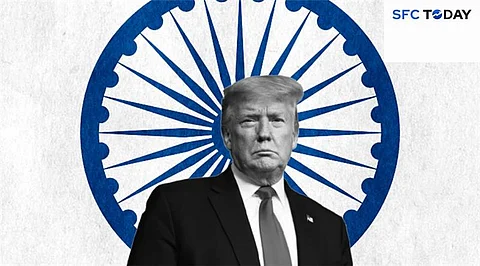

The sudden announcement of 25% tariffs by Donald Trump on Indian exports has caused ripples across the Indian stock market. Investors are worried about whether these trade barriers could trigger a larger market downturn. Whenever such tariffs are introduced, exportoriented sectors feel the immediate impact, and the fear of capital outflows rises. Yet the bigger question remains: will this move truly derail India’s stock market or simply create temporary turbulence?
Indian equity markets responded immediately to the U.S. tariff announcement. The Nifty 50 slipped from around 24,855 to 24,565 in the days following the news, while the Sensex declined from 81,481 to 80,599. Midcap and smallcap indices also faced sharp selling pressure as investors worried about a slowdown in exports and the possibility of foreign investors exiting.
The impact was not limited to a single day. Investors began tracking foreign portfolio investment trends more closely, as the market has already witnessed over ₹61,000 crore in outflows in 2025. Tariffs added a new layer of uncertainty to an already volatile environment. Despite the initial fall, the first week of August saw a mild rebound. On August 4, 2025, the Nifty opened higher at 24,637, and the Sensex climbed to 80,800, suggesting that domestic investors still have confidence in India’s economic resilience.
The United States is a crucial trading partner for India, importing large quantities of pharmaceuticals, textiles, auto components, and gems and jewellery. A 25% tariff makes these products significantly costlier in the American market, which can reduce demand. Economists predict that these tariffs could shave off about 0.4% from India’s GDP growth for the financial year 202526.
A slowdown in exports is also likely to affect employment in industries dependent on U.S. orders. Textile clusters in Tamil Nadu and Gujarat, auto component hubs in Maharashtra, and pharmaceutical plants in Hyderabad may face a temporary decline in production if U.S. demand weakens. Despite this, India’s domestic demand continues to serve as a strong cushion. The country is still expected to grow at 6.3% to 6.8% in 202526, making it one of the fastestgrowing major economies.
Certain sectors are more vulnerable to Trump’s tariffs than others. Pharmaceuticals have already experienced price corrections in the market. Companies like Dr. Reddy’s Laboratories and Sun Pharma depend heavily on the U.S. market, and higher tariffs threaten to reduce profitability. The textile and apparel industry is facing a similar challenge. India competes with countries like Bangladesh and Vietnam, and costlier exports make it easier for U.S. buyers to shift to cheaper alternatives.
The auto components industry, which supplies parts to American carmakers, could also face reduced orders or renegotiated contracts. Gems and jewellery exports are another area of concern since the U.S. is a top buyer of Indian diamonds and finished jewellery. Even sectors not directly under tariffs, such as IT services and electronics, may feel indirect pressure if global trade slows and business sentiment weakens.
Despite the immediate concerns, several factors support the argument that India’s stock market will not completely derail. The first and most important reason is the strength of domestic consumption. Sectors like banking, consumer goods, and infrastructure rely primarily on the domestic market and remain largely insulated from the impact of U.S. trade policies.
Corporate earnings have also remained strong. Many companies posted robust quarterly results, proving that domestic demand is still growing and business fundamentals remain sound. This earnings strength is likely to provide a cushion for equity markets. In addition, the government and the Reserve Bank of India are expected to respond if volatility persists. Policy measures to support exporters, maintain liquidity, and ensure investor confidence could help stabilize market sentiment.
Another factor in India’s favor is export diversification. Over the past few years, Indian exporters have expanded to Europe, the Middle East, and Southeast Asia. This reduces dependence on the U.S. and limits the overall damage of tariffs. From a market perspective, technical support levels have also held firm. The Nifty has stayed above 24,500, and the Sensex has held near 80,600, which are considered critical levels by traders and analysts.
History shows that global trade tensions rarely lead to a complete market collapse in countries with strong domestic demand. During the 2018 U.S.China trade war, Indian markets initially corrected but recovered as domestic flows and earnings growth stabilized sentiment. Even in early 2025, when global interest rate worries shook equity markets, a rebound followed once clarity emerged.
India’s market has repeatedly demonstrated that temporary shocks from abroad often create shortterm volatility rather than a lasting downtrend. The key lies in investor perception and the speed of government responses. If the policy environment remains supportive, the market tends to absorb such shocks and regain momentum.
The coming weeks will be critical for India’s markets. Trade talks between the U.S. and India are scheduled for August 25, 2025, and the outcome could shape market sentiment for the rest of the year. A partial rollback of tariffs or sectorspecific relief measures could bring stability and even spark a rally. Conversely, if the tariffs remain in place for several months without relief, foreign investors may continue selling, keeping the market under pressure.
For now, the market appears to be in a phase of cautious optimism. Investors are watching both domestic earnings and global negotiations closely. Exportlinked companies may continue to face headwinds, but sectors driven by local consumption are expected to remain resilient.
Trump’s tariffs have created immediate challenges for India’s exportoriented industries and triggered a wave of caution in the stock market. However, the overall structure of the Indian economy remains robust. Domestic demand is strong, corporate earnings are healthy, and policymakers are prepared to intervene if necessary.
In essence, the tariffs are more of a temporary speed bump than a permanent roadblock. Shortterm volatility may persist, especially in sectors directly affected by the U.S. duties, but a major market derailment appears unlikely. India’s stock market has weathered external shocks before, and with its strong domestic foundation, it is wellpositioned to overcome this one too.